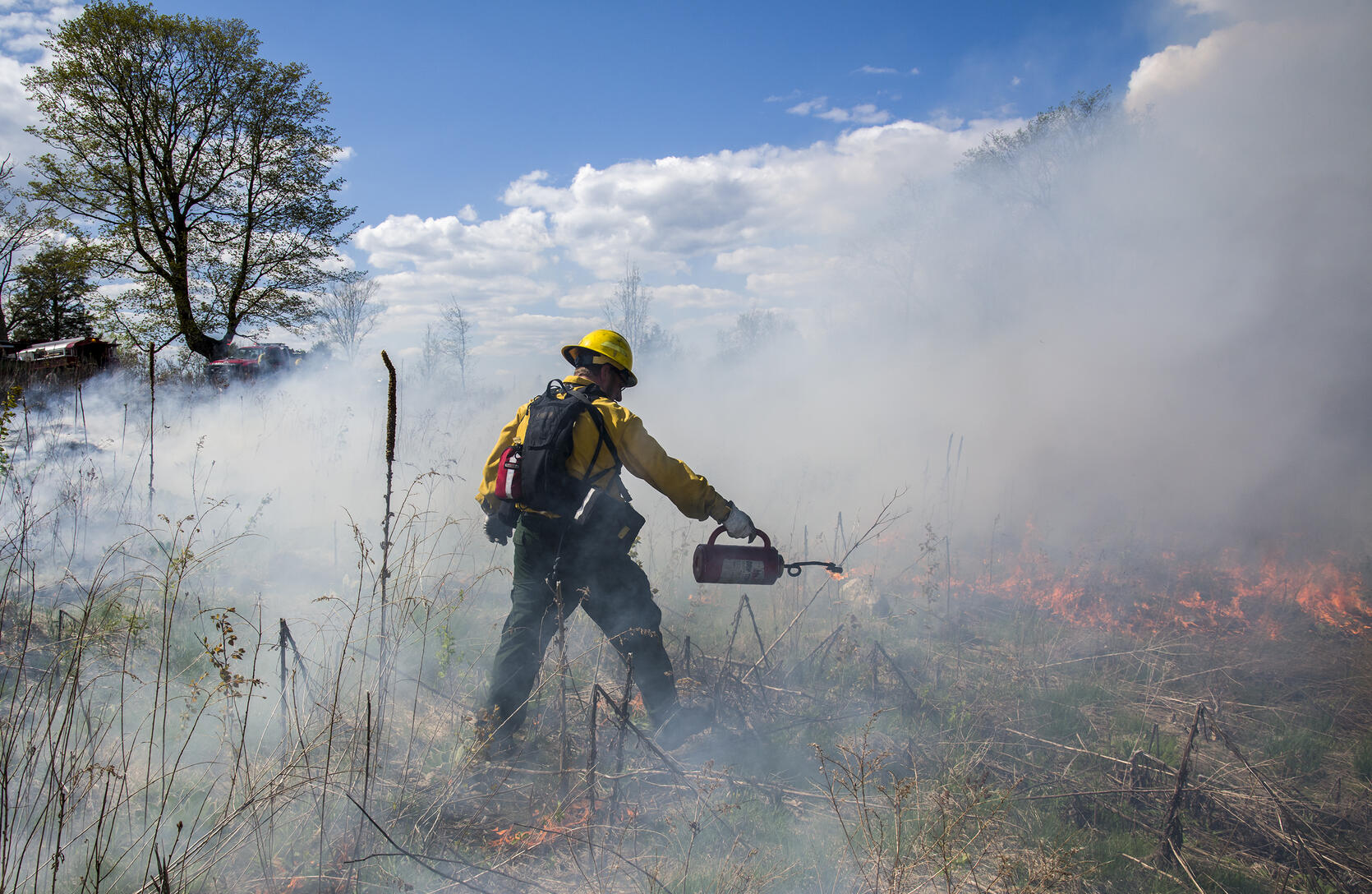- Division of Fisheries and Wildlife
- MassWildlife's Natural Heritage & Endangered Species Program
Media Contact
Media Contact, MassWildlife

January doesn’t seem like a time for thinking about prescribed burns, but planning for a prescribed burn takes place throughout the year and starts months, or even years, in advance. There are several major steps in the process, the first of which is to identify suitable areas that would benefit from a prescribed fire. The Biodiversity Initiative—a team including MassWildlife's fire ecologist, habitat biologists, foresters, and restoration ecologists—assembles to look at the fire-influenced landscapes across the state. Sites are chosen based on the abundance of plants and animals, including those protected by the Massachusetts Endangered Species Act, that require fire to survive. Sometimes these habitats and plant communities are easily identified. Other times, they are hidden by dense, overgrown shrubs and trees that have taken over in the absence of periodic fire. MassWildlife ecologists and foresters search for clues of historic fire such as fire scarring on older trees or declining fire adapted plants such as wild lupine.
Once a location is identified, the planning begins! The Biodiversity Initiative creates a habitat plan that sets a goal for resource management and outlines how the workflow will achieve that goal. The habitat plan often outlines months or years of restoration work for a particular site. It includes any preparation work that needs to be done—a site may need tree thinning or mowing to reduce heavy fuel loads and allow for safe burning. If so, a forest cutting plan is written and forestry practices are undertaken with careful consideration of wildlife values and future prescribed fire needs. Another site may need treatment and control of invasive plants before fire can be reintroduced. Some sites may be ready to go and just need the prescribed fire plan.
A qualified burn planner, familiar with fuels, fire behavior, and prevailing weather conditions in different parts of the state, writes a prescribed fire plan for a site. MassWildlife works closely with public and private partners, neighboring landowners, MassDCR Bureau of Forest Fire Control, local fire departments, and other prescribed fire experts to develop a realistic conservation vision for prescribed fire and set safe standards for implementation of prescribed fire. Although all prescribed burn plans are based on established protocols developed by the National Wildfire Coordinating Group, the plan is altered to fit the needs of the area, where the landscape, specific vegetation, and localized weather patterns can be vastly different from location to location. The plan includes a detailed description of the on-site and off-site vegetation and fuels, objectives for burning, procedures for ignition, holding, and smoke management. Maps of the project area, fuels, and the surrounding landscape are included, the plan may identify one to several burn units and the safety perimeters or fire breaks needed to contain the burn within those designated units. The plan also identifies fuels and hazards outside the burn units and outlines contingency plans and procedures to mitigate or suppress fire that escapes a particular unit or project area. The plan details the resources needed, strategies to be used to start, maintain, and extinguish the fire, and all other elements that need addressing. Most importantly, the plan includes important safety information and planning for the crew and public.
After the prescribed burn plan is completed and approved, the necessary permits are obtained and important notifications and outreach are made to neighbors, partners, and the local community prior to any burning. The Massachusetts Department of Environmental Protection reviews any impact on air quality before issuing an Air Quality Permit. MassWildlife’s Natural Heritage and Endangered Species Program reviews the plan and the burn area for any potential impacts to rare or endangered species, while local Conservation Commissions review the plan for any impacts on wetlands. The municipal fire chief is consulted throughout the planning process and gives permission to conduct the prescribed burn on the actual day of the burn operation.
With all permissions given and permits in place, the burn unit is inspected for hazards such as holes or snags and the unit is prepared. The fire lines around the perimeter of the unit are mowed or cleared to a certain width to create a break in the fuels and boundaries to contain the prescribed fire. Heavy fuels and highly combustible materials are relocated as appropriate. During this time, a window of opportunity in which the burn could potentially occur is identified and adjacent and close neighbors are notified of a potential prescribed burn that will occur. Since appropriate conditions for burning are weather dependent, scheduling of a burn is often limited to no more than one day in advance.
The day before—or the early morning of—a prescribed burn, the DEP Air Quality representative for the particular region and the fire chief are notified by MassWildlife. A final walk-through is completed by the agency representative and the burn boss. These individuals make sure the ground conditions match what is expected and are favorable for a prescribed burn. Any obvious issues are noted. A spot fire weather forecast is obtained from the National Weather Service, and the weather on site is checked and compared with the forecast. All of this information is reviewed by the burn boss who gives the final GO or NO GO for the prescribed burn.
While a prescribed burn from may take only a day, the planning for this day spans months and even years. From identifying lands that benefit from prescribed fires, evaluating fuel conditions, determining the need for other complementary treatments, writing the prescription, obtaining all of the permissions, making notifications, and then preparing the area for the actual burn date, a lot of preparation goes into the planning. The planning process could not be done without the help of numerous individuals sharing their expertise and the partnership of other agencies and organizations to accomplish this important task.

